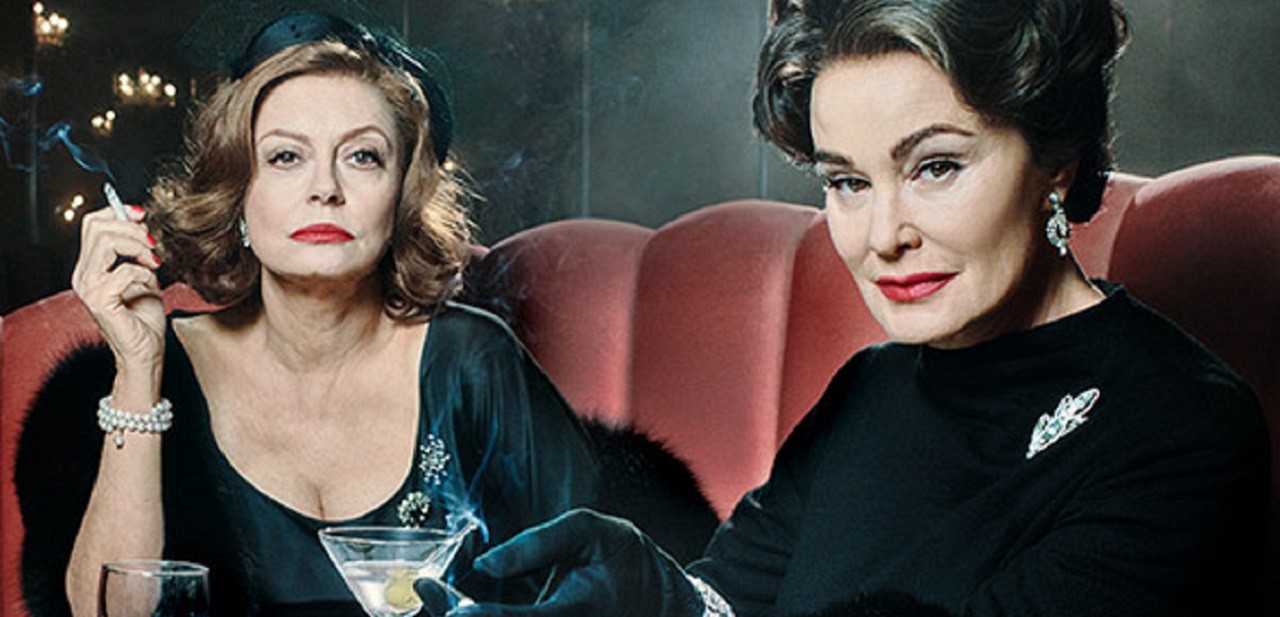Feud: Bette and Joan
Directed by Ryan Murphy
Written by Ryan Murphy, Jaffe Cohen, and Michael Zam
FX Network
THE TITLE of this eight-part series that aired on FX refers to the famous feud between those titans of Tinseltown who costarred in What Ever Happened to Baby Jane?, Bette Davis and Joan Crawford. Following on the heels of Ryan Murphy’s foray into true crime TV, 2016’s People v. O.J. Simpson, the new series is a love letter to the making of the Davis-Crawford vehicle, which was released by Warner Brothers in 1962.
Directed by Robert Aldrich, Baby Jane centered around two sisters, Blanche (Crawford), a paraplegic shut-in who was a starlet of yesteryear, and her younger sister Jane Hudson (Davis), a child star of vaudeville turned drunken sadist. In the first episode, Aldrich’s assistant pitches the plot as a “horror-thriller: two broads, former movie stars, a cripple and her crazy sister battling it out in their Hollywood home.” Meanwhile, Crawford is busily hunting for a script in which she could see herself in the starring role, and to that end she dispatches her personal assistant, whom she lovingly calls “Mamacita,” to bring her a stack of pulpy novels for her to sift through. “Nothing Sapphic,” she adds.

Conceptually, what Feud gets right is that it mirrors the thesis of Baby Jane but with a more robustly ironic sensibility. After all, Aldrich and Murphy are after the same idea. The postwar patriarchy that ruled the Hollywood studio system was an absolute power that corrupted absolutely. Its victims are plain to see in Baby Jane and Blanche, child stars of the 1920s, but also in Davis and Crawford decades later—tireless workers, like so many of their generation, still being driven crazy by an exploitative system in which a fat guy chewing a cigar called all the shots. (At one point in Feud the bigwigs complain that Bette Davis has broken the hold of the studio system.)
Veteran scene-stealer Stanley Tucci as studio head Jack Warner is on hand to fill the cigar smoker’s shoes. His opposition to casting Crawford, who had sued him earlier, comes across as cruel and childish. Even if Jane Hudson’s egotism looks more grotesque onscreen than that of her long-suffering sister, both of the Hudsons suffered from a kind of delusion unique to a work environment where rich white guys capitalized on women’s talents and beauty only to kick them to the curb when newer makes and models came along. Can you imagine a film in which the Hemsworth or Bridges brothers cut themselves off from the outside world only to wage war against each other? This explains why, early in the series, Crawford arrives on set like Santa Claus, giving gifts to every guy in the crew. She may have simply wanted to upstage her costar or she may have shrewdly divined that time was running out for her as something rare in her era: a self-made woman in the mold of her greatest role, as Mildred Pierce (1945), for which she was awarded the Oscar for Best Actress.
The tragi-comic power of Feud owes everything to Murphy’s casting. Both pitch perfect in their roles, Jessica Lange as Crawford and Susan Sarandon as Davis are two of the hardest-working actresses around. Lange snagged her Oscar for a forgettable film called Blue Sky back in 1996, while Sarandon won for Dead Man Walking the following year. We learn from Feud that the kabuki makeup and runny mascara used to construct the gothic visage of Jane Hudson was Davis’ own design. The pilot is full of laugh-out-loud lines, but one jaw-dropper in particular occurs in the episode titled “Mommie Dearest” when Davis and Crawford attempt to share a civil meal together and bond over their life’s hardships, chain-smoking and martini-swilling all the while. Asked about her first sexual experience, Lange confesses, without an iota of shame, that she lost her virginity to her step-father, adding: “But he wasn’t my Daddy, so it wasn’t incest. … I led him into it.” Sarandon looks dumbfounded, and after she offers her own war story, she tells her costar: “I mean it, Lucille”—Davis would call Crawford by her given name to humble her—“I’m going to support this picture even if it means supporting you, too.” It’s a standout scene in which two battle-axes let down their guard, showing that even the fiercest of enemies had to band together if they wanted to make it in a man’s world.
No title on my bookshelf elicits more jokes from friends than How to Be Gay by David M. Halperin, a classics scholar and a professor at the University of Michigan. The quips include “You mean you need an instruction manual?” and “Aren’t you already an expert?” In the book, Halperin comes out as a Joan Crawford groupie and writes about Baby Jane, which he dubs a “gothic psycho-thriller,” that it “elicits gales of laughter from gay male audiences, who delight in the melodramatic confrontations between Bette Davis and Joan Crawford, those ancient Hollywood rivals, both playing once-glamorous and now-fallen stars locked in a demented battle for supremacy: grotesque, extravagant images of a monstrous, abject femininity.” Halperin also explores the complexities of “camp,” but it’s Murphy himself, in a cover story he contributed to Out magazine, who sums up the popularity of camp heroines among gay men : “I think it has a lot to do with a projection of the person one wants to be in the world. You’re a survivor. … I look at you as someone nobody could ever keep down, who has a huge reservoir of passion.” This is not to say that Crawford, or Davis, saw their admirers in this way. In the final episode of Feud, a giddy gay fan gushes to Crawford at a book signing that Blanche and Baby Jane are “survivors,” whereupon the irascible actress retorts: “What do you know about surviving?”
Though her birthdate is still uncertain, Crawford died at the age of 73-ish in 1977, one year prior to the publication of her daughter Christina’s revenge memoir, Mommie Dearest. Yet in the final episode of Feud, in a voice-over, Crawford tells us her side of that even more notorious feud: “Every woman tries to be a good mother and wonders if, after all her efforts, her children will wind up on a headshrinker’s couch, complaining about their treatment.” Had she lived, Crawford would have received the shock of her life with the film version of Mommie Dearest in 1981. As Crawford, Faye Dunaway played the star as an unglued glamorpuss with caterpillar eyebrows and a Medusa stare. Drag queens have been recreating the role for decades. Meanwhile, in that same year, Kim Carnes released the gravely-throated hit single, “Bette Davis Eyes,” and it’s debatable which work would have outraged Davis’ arch-nemesis more. Imagine an aged Crawford hearing the lyric, “All the boys think she’s a spy, she’s got Bette Davis eyes,” turning off the radio and grumbling to herself: Where the hell is my song? Now at least, thanks to Ryan Murphy’s series, she can share the airwaves with her rival on an equal footing.
Colin Carman, PhD, teaches British Romanticism and lgbtq studies at Colorado Mesa University in Grand Junction, Colorado.






